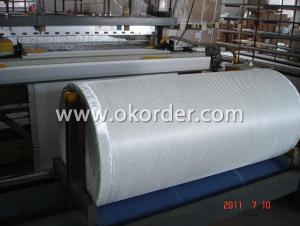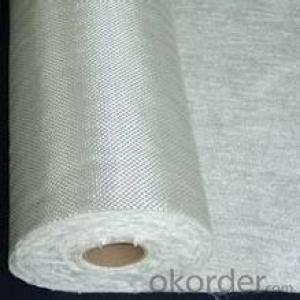Fiberglass Roofing Fabric with Medium Silica Fiberglass Fabrics
- Loading Port:
- China Main Port
- Payment Terms:
- TT or LC
- Min Order Qty:
- 2000kg kg
- Supply Capability:
- -
OKorder Service Pledge
OKorder Financial Service
You Might Also Like
1.Brief Introduction:
Medium silica fabrics can be used for a long period of time without changing their properties perat the temperature of 800℃ as it contains more than 70%±5% silica.

2.Properties
No asbestos orceramic,no harm to human
Low thermal conductivity,excellent thermal insulation
Superb electric insulation
Inert to majority of chemical reagents
Good flexibility

3.Application
Fire fighting
High temperature gas filtration
Thermal insulation

4.Specification
| Type | Weave Type | Area Weight | Width cm | Thickness | Warp Yarns/cm | Weft yarns/cm |
| RS-600 | Satin 8HS | 600±50 | 100 | 0.75±0.1 | 18±1 | 13±1 |
| RS-1100 | Satin 12HS | 1100±50 | 100 | 1.35±0.1 | 18±1 | 13±1 |
5.Package and Delivery Time.
Packed with carton and pallets.The products will be ready in 15-20 days after the order confirmation.
FAQ:
Delivery Detail: 15-21days
Other spec. can be custom made as per customer's request.
- Q: Sofa three proofing fabric and 6 anti distinction
- Three proof cloth is PVC coated glass fiber cloth. Three cloth is coated on the surface of PVC, PTFE refractory fiber, flame retardant silicone and other refractory materials, make fire waterproof mildew proof function, refractory fiber with fire, PVC, PTFE, silica gel has a waterproof function.
- Q: How does fiberglass fabric compare to carbon fiber fabric?
- Fiberglass fabric and carbon fiber fabric differ in terms of their strength, weight, and cost. While fiberglass fabric is generally less expensive, it is also heavier and not as strong as carbon fiber fabric. Carbon fiber fabric, on the other hand, is lighter and stronger, making it a preferred choice for applications requiring high performance and durability. However, the higher cost of carbon fiber fabric can limit its use in certain industries. Ultimately, the choice between the two depends on the specific requirements and budget of the project at hand.
- Q: How do fiberglass fabrics perform in terms of thermal conductivity?
- Fiberglass fabrics possess a generally low thermal conductivity, thereby effectively preventing the transmission of heat. The distinctive makeup of fiberglass, comprising delicate glass fibers, establishes a barrier that restricts the flow of thermal energy. This attribute renders fiberglass fabrics appropriate for diverse applications necessitating thermal insulation. Whether employed in construction, automotive insulation, or even protective garments, fiberglass fabrics excel in diminishing heat transfer and upholding temperature stability. Moreover, their low thermal conductivity aids energy efficiency by minimizing heat loss or gain, ultimately resulting in reduced energy consumption and cost savings.
- Q: What are the standard widths of fiberglass fabric?
- The standard widths of fiberglass fabric can vary depending on the manufacturer and intended use. However, in general, fiberglass fabric is commonly available in widths ranging from 1 inch to 60 inches. Some manufacturers may offer wider widths up to 120 inches or more. The choice of width depends on the specific application and project requirements. For smaller projects or more intricate details, narrower widths are often preferred, while wider widths are suitable for larger-scale applications. It is important to check with the manufacturer or supplier to confirm the available widths and select the most appropriate option for your specific needs.
- Q: Can fiberglass fabric be used for making gaskets or seals?
- Indeed, the utilization of fiberglass fabric is viable for the production of gaskets and seals. Renowned for its superior potency and durability, fiberglass fabric emerges as an optimal material selection for applications pertaining to gaskets and seals. Its capacity to endure elevated temperatures, withstand chemical substances, and provide insulation properties renders it suitable for deployment across a diverse range of sectors, encompassing automotive, aerospace, and manufacturing. Moreover, the versatility of fiberglass fabric permits effortless cutting and molding into various shapes and sizes, tailored to meet the specific requirements of individual gaskets or seals. Overall, fiberglass fabric showcases commendable sealing capabilities, thereby establishing itself as a dependable option for fabricating gaskets and seals.
- Q: How to deal with cracks in floor construction joints?
- The cracks that do not affect the safety of the structure shall be used in combination with the following methods:Chemical grouting: suitable for through cracks, the use of special pressure equipment, the chemical pulp into the hydraulic pressure, the general chemical grout for epoxy resin, polyurethane and so on.In the original position of the crack sealing slot slot, groove clean, sealing material for fill block, sealing material with epoxy grout, sealing compound, polymer mortar etc..
- Q: Can fiberglass fabrics be used for reinforcement in concrete structures?
- Yes, fiberglass fabrics can be used for reinforcement in concrete structures. Fiberglass fabrics are known for their high tensile strength and corrosion resistance, making them suitable for reinforcing concrete. They can be used as an alternative to traditional steel reinforcement, providing durability and reducing the weight of the structure. Additionally, fiberglass fabrics offer greater flexibility and are easier to handle during construction.
- Q: What are the advantages of using fiberglass fabric in construction?
- Fiberglass fabric offers numerous benefits for construction purposes. Firstly, it boasts exceptional strength and durability, with a high tensile strength that enables it to withstand substantial forces without breaking or tearing. This makes it ideal for reinforcing structures and providing added strength to various construction elements. Secondly, fiberglass fabric is lightweight in comparison to materials like steel or concrete. This lightness makes it easier to handle and transport, resulting in increased efficiency and reduced labor costs during the construction process. Moreover, fiberglass fabric exhibits impressive resistance to corrosion. Unlike metals, which are prone to rust over time, fiberglass fabric remains unaffected, making it a long-lasting and low-maintenance option for construction projects. Its resistance to corrosion also enables its use in various environments, including those with high moisture or chemical levels. Additionally, fiberglass fabric is a non-conductive material, making it perfect for applications where electrical insulation is necessary, such as electrical panels or wiring systems. It provides a safe and reliable solution for preventing electrical currents from passing through and causing potential hazards. Another advantage of using fiberglass fabric in construction lies in its versatility. It can be molded and shaped into various forms, allowing for customization and flexibility in design. This versatility empowers architects and builders to create unique structures and achieve specific aesthetic goals. Lastly, fiberglass fabric is fire-resistant. It possesses a high melting point and does not support combustion, making it a safer option in terms of fire protection. By incorporating fiberglass fabric into construction projects, the risk of fire spreading and causing extensive damage can be significantly reduced. In conclusion, the benefits of using fiberglass fabric in construction include its strength, lightweight nature, corrosion resistance, electrical insulation properties, versatility, and fire-resistant qualities. These advantages make it a reliable and efficient material choice for a wide range of construction applications.
- Q: Can fiberglass fabric be used for making heat shields?
- Indeed, heat shields can be made using fiberglass fabric. Renowned for its exceptional heat resistance properties, fiberglass fabric proves to be an optimal material for heat shielding purposes. Withstanding elevated temperatures without succumbing to melting or deformation, it effectively acts as a protective barrier against heat transfer. Furthermore, fiberglass fabric possesses the advantageous traits of being lightweight, flexible, and possessing commendable insulation properties, rendering it appropriate for a diverse range of heat shield applications across the automotive, aerospace, and industrial sectors.
- Q: Can fiberglass fabric be used for making boats?
- Yes, fiberglass fabric can be used for making boats. Fiberglass is a popular material choice in boat construction due to its strength, durability, and lightweight properties. It is commonly used to create the hulls, decks, and other structural components of boats. Fiberglass fabric is typically applied in layers and then combined with a resin to create a strong and rigid composite material. This combination of fiberglass fabric and resin provides excellent strength-to-weight ratio, making it ideal for boat building. Additionally, fiberglass is resistant to corrosion, rot, and UV damage, making it a suitable material for boats that will be exposed to harsh marine environments. Overall, fiberglass fabric is a versatile material that has been successfully used in the construction of various types of boats, including recreational boats, sailboats, and even high-performance racing boats.
Send your message to us
Fiberglass Roofing Fabric with Medium Silica Fiberglass Fabrics
- Loading Port:
- China Main Port
- Payment Terms:
- TT or LC
- Min Order Qty:
- 2000kg kg
- Supply Capability:
- -
OKorder Service Pledge
OKorder Financial Service
Similar products
Hot products
Hot Searches
Related keywords






























